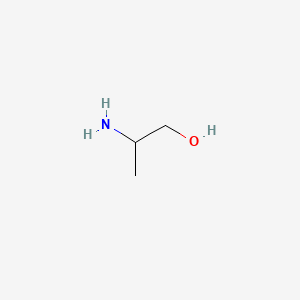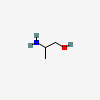DL-Alaninol
- DL-Alaninol
- 6168-72-5
- 2-Aminopropan-1-ol
- 2-Amino-1-propanol
- 2-Aminopropanol
- Create:2005-03-25
- Modify:2024-12-27


- 2-aminopropanol
- 2-aminopropanol, (+-)-isomer
- 2-aminopropanol, (S)-isomer
- alaninol
- DL-Alaninol
- 6168-72-5
- 2-Aminopropan-1-ol
- 2-Amino-1-propanol
- 2-Aminopropanol
- DL-2-Amino-1-propanol
- 1-Propanol, 2-amino-
- 1-Hydroxy-2-aminopropane
- 2-Amino-2-methylethanol
- 78-91-1
- 1-Methyl-2-hydroxyethylamine
- Alaninol
- beta-Propanolamine
- DL-2-Aminopropanol
- (+/-)-2-Amino-1-propanol
- .beta.-Propanolamine
- 1-Propanol, 2-amino-, DL-
- NSC 1360
- 2-hydroxy-1-methylethylamine
- E8V71RA4B5
- NSC-1360
- MFCD00064413
- 1-Propanol, 2-amino-, (.+/-.)-
- Propanol, 2-amino-
- [1-(hydroxymethyl)ethyl]amine
- L-(+)-2-Amino propanol
- (1-(HYDROXYMETHYL)ETHYL)AMINE
- UNII-E8V71RA4B5
- 2-Aminopropanol, (+/-)-
- DL Alaninol
- beta-aminopropanol
- 2-amino-propanol
- DL 2-aminopropanol
- EINECS 201-156-4
- EINECS 228-207-3
- MFCD00008085
- 2-amino-1 propanol
- (RS)-2-aminopropanol
- 2-Amino-propan-1-ol
- DL-Alaninol, 98%
- 1-hydroxymethylethylamine
- 1-hydroxyprop-2-ylamine
- 1-hydroxypropan-2-amine
- rac-2-amino-1-propanol
- (.+/-.)-Alaninol
- 2-amino-1-hydroxypropane
- L-(+)-ALANINOL
- racemic 2-amino-1-propanol
- .BETA.-AMINOPROPANOL
- (2rs)-2-amino-1-propanol
- 2-AMINOPROPANOL [MI]
- propane, 2-amino-1-hydroxy-
- CHEMBL116663
- (2-RS)-2-amino-1-propanol
- DTXSID50865762
- NSC1360
- (+/-)-2-AMINOPROPANOL
- CHEBI:195477
- 1-Propanol, 2-amino-, (S)-
- (.+/-.)-2-Amino-1-propanol
- BCP13388
- 2-AMINOPROPANOL DL-FORM [MI]
- AKOS000121886
- AKOS016842421
- CS-W018531
- GS-6800
- SB11311
- SB11312
- AC-24046
- SY002757
- DB-047233
- DB-048780
- DB-053967
- A0942
- NS00001640
- NS00096434
- EN300-29387
- J-508068
- Q27277018
- F0001-1637
- (S)-(+)-2-Amino-1-propanol; (+)-2-Aminopropan-1-ol;L-(+)-Alaninol
Information on 2 consumer products that contain 2-amino-1-propanol in the following categories is provided:
• Inside the Home


H302 (13.2%): Harmful if swallowed [Warning Acute toxicity, oral]
H314 (34.8%): Causes severe skin burns and eye damage [Danger Skin corrosion/irritation]
H318 (25.7%): Causes serious eye damage [Danger Serious eye damage/eye irritation]
H412 (12.9%): Harmful to aquatic life with long lasting effects [Hazardous to the aquatic environment, long-term hazard]
P260, P264, P264+P265, P270, P273, P280, P301+P317, P301+P330+P331, P302+P361+P354, P304+P340, P305+P354+P338, P316, P317, P321, P330, P363, P405, and P501
(The corresponding statement to each P-code can be found at the GHS Classification page.)
Aggregated GHS information provided per 676 reports by companies from 11 notifications to the ECHA C&L Inventory. Each notification may be associated with multiple companies.
Reported as not meeting GHS hazard criteria per 441 of 676 reports by companies. For more detailed information, please visit ECHA C&L website.
There are 10 notifications provided by 235 of 676 reports by companies with hazard statement code(s).
Information may vary between notifications depending on impurities, additives, and other factors. The percentage value in parenthesis indicates the notified classification ratio from companies that provide hazard codes. Only hazard codes with percentage values above 10% are shown.
Acute Tox. 4 (13.2%)
Skin Corr. 1B (34.8%)
Eye Dam. 1 (25.7%)
Aquatic Chronic 3 (12.9%)
Special Hazards of Combustion Products: Toxic oxides of nitrogen may form in fire.
Behavior in Fire: May produce toxic oxides of nitrogen. (USCG, 1999)
INHALATION: Move victim to fresh air. If not breathing, give artificial respiration. If breathing is difficult, give oxygen.
SKIN AND EYES: Immediately flush skin or eyes with running water for at least 15 minutes; hold eyelids open if necessary. Remove and isolate contaminated clothing and shoes. Maintain normal body temperture. (USCG, 1999)
Excerpt from ERG Guide 153 [Substances - Toxic and/or Corrosive (Combustible)]:
IMMEDIATE PRECAUTIONARY MEASURE: Isolate spill or leak area in all directions for at least 50 meters (150 feet) for liquids and at least 25 meters (75 feet) for solids.
SPILL: Increase the immediate precautionary measure distance, in the downwind direction, as necessary.
FIRE: If tank, rail tank car or highway tank is involved in a fire, ISOLATE for 800 meters (1/2 mile) in all directions; also, consider initial evacuation for 800 meters (1/2 mile) in all directions. (ERG, 2024)
Alcohols and Polyols
Amines, Phosphines, and Pyridines
Patents are available for this chemical structure:
https://patentscope.wipo.int/search/en/result.jsf?inchikey=BKMMTJMQCTUHRP-UHFFFAOYSA-N
- Australian Industrial Chemicals Introduction Scheme (AICIS)1-Propanol, 2-amino-, (.+-.)-https://services.industrialchemicals.gov.au/search-inventory/
- CAMEO ChemicalsLICENSECAMEO Chemicals and all other CAMEO products are available at no charge to those organizations and individuals (recipients) responsible for the safe handling of chemicals. However, some of the chemical data itself is subject to the copyright restrictions of the companies or organizations that provided the data.https://cameochemicals.noaa.gov/help/reference/terms_and_conditions.htm?d_f=false2-PROPANOLAMINEhttps://cameochemicals.noaa.gov/chemical/10280CAMEO Chemical Reactivity Classificationhttps://cameochemicals.noaa.gov/browse/react
- CAS Common ChemistryLICENSEThe data from CAS Common Chemistry is provided under a CC-BY-NC 4.0 license, unless otherwise stated.https://creativecommons.org/licenses/by-nc/4.0/DL-2-Amino-1-propanolhttps://commonchemistry.cas.org/detail?cas_rn=6168-72-5
- ChemIDplusChemIDplus Chemical Information Classificationhttps://pubchem.ncbi.nlm.nih.gov/source/ChemIDplus
- DTP/NCILICENSEUnless otherwise indicated, all text within NCI products is free of copyright and may be reused without our permission. Credit the National Cancer Institute as the source.https://www.cancer.gov/policies/copyright-reuse
- EPA Chemicals under the TSCA1-Propanol, 2-amino-https://www.epa.gov/chemicals-under-tscaEPA TSCA Classificationhttps://www.epa.gov/tsca-inventory
- EPA DSSTox2-Amino-1-propanolhttps://comptox.epa.gov/dashboard/DTXSID50865762CompTox Chemicals Dashboard Chemical Listshttps://comptox.epa.gov/dashboard/chemical-lists/
- European Chemicals Agency (ECHA)LICENSEUse of the information, documents and data from the ECHA website is subject to the terms and conditions of this Legal Notice, and subject to other binding limitations provided for under applicable law, the information, documents and data made available on the ECHA website may be reproduced, distributed and/or used, totally or in part, for non-commercial purposes provided that ECHA is acknowledged as the source: "Source: European Chemicals Agency, http://echa.europa.eu/". Such acknowledgement must be included in each copy of the material. ECHA permits and encourages organisations and individuals to create links to the ECHA website under the following cumulative conditions: Links can only be made to webpages that provide a link to the Legal Notice page.https://echa.europa.eu/web/guest/legal-noticeDL-2-aminopropan-1-olhttps://chem.echa.europa.eu/100.025.6442-aminopropan-1-olhttps://echa.europa.eu/substance-information/-/substanceinfo/100.001.052DL-2-aminopropan-1-ol (EC: 228-207-3)https://echa.europa.eu/information-on-chemicals/cl-inventory-database/-/discli/details/481812-aminopropan-1-ol (EC: 201-156-4)https://echa.europa.eu/information-on-chemicals/cl-inventory-database/-/discli/details/76495
- FDA Global Substance Registration System (GSRS)LICENSEUnless otherwise noted, the contents of the FDA website (www.fda.gov), both text and graphics, are not copyrighted. They are in the public domain and may be republished, reprinted and otherwise used freely by anyone without the need to obtain permission from FDA. Credit to the U.S. Food and Drug Administration as the source is appreciated but not required.https://www.fda.gov/about-fda/about-website/website-policies#linking2-AMINOPROPANOL, (±)-https://gsrs.ncats.nih.gov/ginas/app/beta/substances/E8V71RA4B5
- New Zealand Environmental Protection Authority (EPA)LICENSEThis work is licensed under the Creative Commons Attribution-ShareAlike 4.0 International licence.https://www.epa.govt.nz/about-this-site/general-copyright-statement/
- Haz-Map, Information on Hazardous Chemicals and Occupational DiseasesLICENSECopyright (c) 2022 Haz-Map(R). All rights reserved. Unless otherwise indicated, all materials from Haz-Map are copyrighted by Haz-Map(R). No part of these materials, either text or image may be used for any purpose other than for personal use. Therefore, reproduction, modification, storage in a retrieval system or retransmission, in any form or by any means, electronic, mechanical or otherwise, for reasons other than personal use, is strictly prohibited without prior written permission.https://haz-map.com/About2-Amino-1-propanol, DL-https://haz-map.com/Agents/20667
- ChEBI2-aminopropan-1-olhttps://www.ebi.ac.uk/chebi/searchId.do?chebiId=CHEBI:195477
- LOTUS - the natural products occurrence databaseLICENSEThe code for LOTUS is released under the GNU General Public License v3.0.https://lotus.nprod.net/DL-Alaninolhttps://www.wikidata.org/wiki/Q27277018LOTUS Treehttps://lotus.naturalproducts.net/
- ChEMBLLICENSEAccess to the web interface of ChEMBL is made under the EBI's Terms of Use (http://www.ebi.ac.uk/Information/termsofuse.html). The ChEMBL data is made available on a Creative Commons Attribution-Share Alike 3.0 Unported License (http://creativecommons.org/licenses/by-sa/3.0/).http://www.ebi.ac.uk/Information/termsofuse.html
- Consumer Product Information Database (CPID)LICENSECopyright (c) 2024 DeLima Associates. All rights reserved. Unless otherwise indicated, all materials from CPID are copyrighted by DeLima Associates. No part of these materials, either text or image may be used for any purpose other than for personal use. Therefore, reproduction, modification, storage in a retrieval system or retransmission, in any form or by any means, electronic, mechanical or otherwise, for reasons other than personal use, is strictly prohibited without prior written permission.https://www.whatsinproducts.com/contents/view/1/62-amino-1-propanolhttps://www.whatsinproducts.com/chemicals/view/1/1515/006168-72-5Consumer Products Category Classificationhttps://www.whatsinproducts.com/
- IUPAC Digitized pKa Datasetpropane, 2-amino-1-hydroxy-https://github.com/IUPAC/Dissociation-Constants
- Japan Chemical Substance Dictionary (Nikkaji)
- KNApSAcK Species-Metabolite Database
- Natural Product Activity and Species Source (NPASS)2-Aminopropan-1-Olhttps://bidd.group/NPASS/compound.php?compoundID=NPC145217
- Metabolomics Workbench2-aminopropan-1-olhttps://www.metabolomicsworkbench.org/data/StructureData.php?RegNo=71477
- NIST Mass Spectrometry Data CenterLICENSEData covered by the Standard Reference Data Act of 1968 as amended.https://www.nist.gov/srd/public-law1-Propanol, 2-amino-, (.+/-.)-http://www.nist.gov/srd/nist1a.cfm
- SpectraBase1-PROPANOL, 2-AMINO-https://spectrabase.com/spectrum/LEVgS3zNzvX1-Propanol, 2-amino-https://spectrabase.com/spectrum/1V4pjQV13mS2-AMINO-1-PROPANOLhttps://spectrabase.com/spectrum/GrJsZWhOSe8L-2-AMINO-1-PROPANOLhttps://spectrabase.com/spectrum/Gxdx7dsExwgL-2-amino-1-propanolhttps://spectrabase.com/spectrum/Rr2ToUEBfNL-2-amino-1-propanolhttps://spectrabase.com/spectrum/6rcCrlwfz341-METHYL-2-HYDROXYETHYLAMINEhttps://spectrabase.com/spectrum/Ct9vJQdSmaG2-Amino-1-propanolhttps://spectrabase.com/spectrum/FNEaSHDvDSq2-AMINO-1-PROPANOLhttps://spectrabase.com/spectrum/K6IyXijAAzLL-2-AMINO-1-PROPANOLhttps://spectrabase.com/spectrum/3osovPwO9II1-PROPANOL, 2-AMINO-,https://spectrabase.com/spectrum/1wYA2wLPDI6DL-Alaninolhttps://spectrabase.com/spectrum/5oHRndgWiEI1-Propanol, 2-amino-, (+/-)-https://spectrabase.com/spectrum/JNpzrd7hsDg1-Propanol, 2-amino-, (+/-)-https://spectrabase.com/spectrum/8nU6uA11K0eDL-Alaninolhttps://spectrabase.com/spectrum/1newxRNPpsDDL-Alaninolhttps://spectrabase.com/spectrum/ImAlpibAzrV
- Springer Nature
- Thieme ChemistryLICENSEThe Thieme Chemistry contribution within PubChem is provided under a CC-BY-NC-ND 4.0 license, unless otherwise stated.https://creativecommons.org/licenses/by-nc-nd/4.0/
- Wikidata(RS)-2-aminopropanolhttps://www.wikidata.org/wiki/Q27277018
- Wikipedia
- Wiley
- PubChem
- Medical Subject Headings (MeSH)LICENSEWorks produced by the U.S. government are not subject to copyright protection in the United States. Any such works found on National Library of Medicine (NLM) Web sites may be freely used or reproduced without permission in the U.S.https://www.nlm.nih.gov/copyright.html2-aminopropanolhttps://www.ncbi.nlm.nih.gov/mesh/67034448
- GHS Classification (UNECE)GHS Classification Treehttp://www.unece.org/trans/danger/publi/ghs/ghs_welcome_e.html
- NORMAN Suspect List ExchangeLICENSEData: CC-BY 4.0; Code (hosted by ECI, LCSB): Artistic-2.0https://creativecommons.org/licenses/by/4.0/NORMAN Suspect List Exchange Classificationhttps://www.norman-network.com/nds/SLE/
- EPA Substance Registry ServicesEPA SRS List Classificationhttps://sor.epa.gov/sor_internet/registry/substreg/LandingPage.do
- MolGenieMolGenie Organic Chemistry Ontologyhttps://github.com/MolGenie/ontology/
- PATENTSCOPE (WIPO)SID 403390863https://pubchem.ncbi.nlm.nih.gov/substance/403390863

